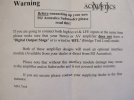Am I right that this is the case with the vast majority of class D, so these Fosi monos are not at all unusual, and it would be the same with say, an Aiyima A07.No, not necessarily. Many subs have a grounded black terminal for high level inputs - which is not compatible with a class D amp with bridge tied load such as this one. Best to check with the sub manufacturer.
In that case it is usually possible to connect one speaker terminal to the red channel of the sub, and connect the black terminal of the sub back to an earth point on the amp - ususallly the ring of an unused RCA connector. However, again it is necessary to check with the sub manufacturer the compatibility of this approach.
I have speaker level inputs and the manufacturers advice is to make sure that the line levels are not connected at the same time.
But another manufacturer (REL) suggested connecting with the line level to line level, but with the line level volume down.
So quite confusing.
